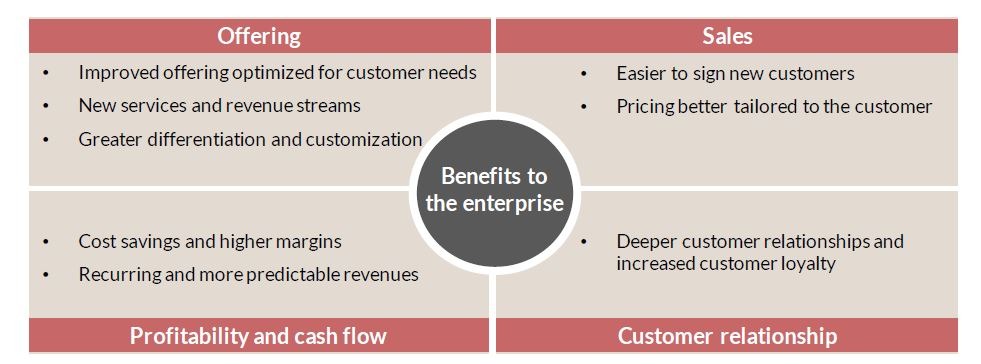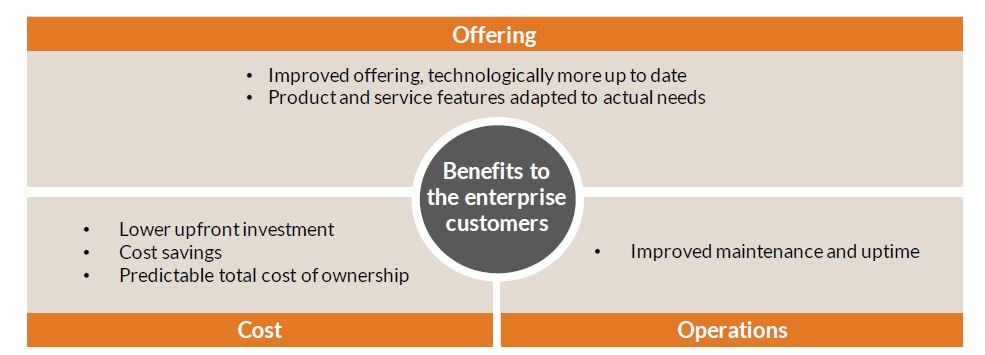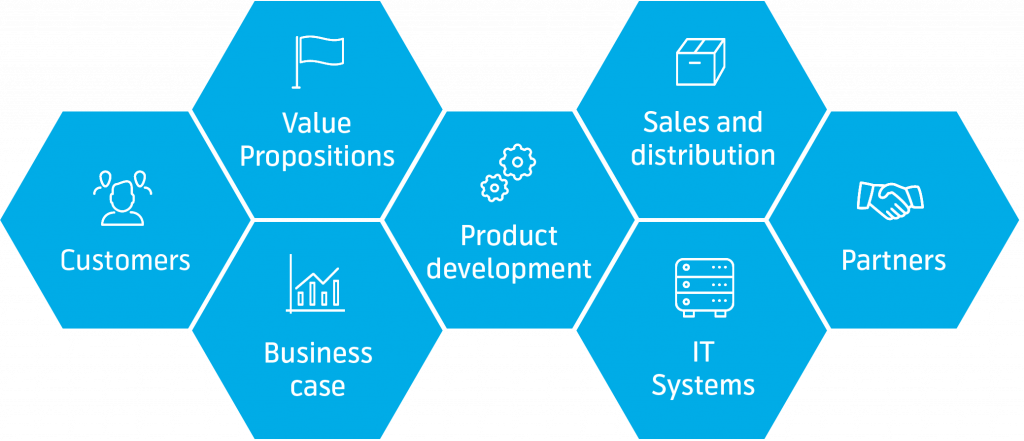As companies embark on the journey of connecting their products to realize the benefits of IoT, the initial business case is often focused on cost savings. However, a big opportunity lies in creating new business models to build deeper customer relationships and increase revenues. One such way to redefine the business model is to turn a traditional product into a connected product-as- a-service. This type of servitization entails a fundamental shift in mindset from selling a finished product in a single transaction to providing solutions to customer problems and charging for usage or performance.
Implementing such a model requires a business transformation that impacts the whole organization. This is a challenging process but it can bring significant benefits both to the enterprise and to its customers. Enterprises can improve their offering by receiving data on product usage and performance, launch new services and build stronger customer relationships centered around service, support and resolving customer problems.
In addition, enterprises can improve sales by lowering the initial investment for a customer and offering better tailored pricing models, which together with cost savings on maintenance and more predictable revenue streams result in improved overall profitability and cash flow.
Transforming the business model to a product-as-a-service through IoT impacts the whole organization – from strategy to processes, people and technology. Companies face a range of considerations and strategic questions pertaining to:
There are some best practices that have proven useful in helping enterprises succeed on this journey. Already from the start, it is important to put strategy in the lead and ensure that technology serves the strategic objectives. Transformation is also unlikely to succeed unless there is strong support and commitment from the management team. Forming a dedicated, cross-functional team with both technical and commercial expertise often helps companies innovate and make faster progress.
A key to success is also to start small, with a few customers and selected use cases, in order to test and adapt the model. Last but not least, companies should scale and deploy fully the model once they feel confident that the risks have been addressed and the outcome is predictable.
IoT is high on the agenda for many enterprises and there is little doubt that the impact and potential are tremendous. The initial business case for connecting products is usually focused on realizing cost savings, for example, by optimizing service and maintenance. Most companies that have deployed IoT are still at this initial stage.
For many enterprises, there is an even larger opportunity that lies in creating new business models to build deeper customer relationships, improve the value proposition and increase revenues. One such way to redefine the business model is to turn a traditional product into a connected product-as-a-service.
However, to implement and fully capitalize on such a new model, an enterprise needs to make some fundamental changes and transform its business. Such a journey poses a series of strategic questions. What are the main benefits to the enterprise and its customers? What are the key considerations and challenges in the process? What are the best practices that can help to ensure a successful transformation?
This paper aims to act as a guide about the journey from product to a connected product-as-a-service business model, providing insights on the key questions above.
What does a connected product-as-a-service entail? It is a business model, in which the enterprise sells an integrated package that includes hardware, software, connectivity, maintenance, customer support, installation and other value adding services for a recurring fee. Such a business model innovation centered around service orientation is often referred to as “servitization”. The most fundamental change is the shift in mindset from selling products to providing solutions to customer needs and problems, whereby customers pay for the performance, usage or outcome.
The as-a-service model in itself is not new. It is widely adopted by technology companies such as Microsoft and IBM offering software-as-a-service (SaaS). SaaS has become a standard delivery model for many business applications, including office software, and has made subscription services generally accepted, thus paving the road for product-as-a-service.
One variation of a connected product-as-a-service is found in the growing sharing economy, especially for cars and bicycles. The shared use of such assets reduces both the cost and the environmental impact, thus expanding substantially the potential target group.
DriveNow is one example of a company that offers car-as-a- service. Customers can via the app quickly find, reserve and unlock an available car in their vicinity and use the car as long as needed. When finished, they simply leave the car at the closest public parking and end the booking. Pricing is usage based (per minute) and includes insurance, tax, parking and fuel.
Another example is Connected Cycle, a French startup that has built a smart bike pedal equipped with GPS, sensors and connectivity. When the user starts pedaling, the sensors activate and track location, speed and incline. It can be used as a fitness tracker but also to locate the bike in the case of theft. The company has also developed a fleet management solution that can be used by bicycle sharing programs or bike rental businesses to offer a connected bike-as-a-service.
As illustrated in the two examples above, the ability to receive and analyze data is essential in order to deliver the value in product-as-a-service. This makes IoT a key enabler and a foundation for this transformation.
It is well suited particularly to large and expensive assets with long lifecycles, such as industrial machines, jet engines, trucks and more. Therefore, product-as-a-service business model is likely to be more prevalent and develop faster in B2B rather than B2C customer relationships.
In B2C, the model can be applied to products that certain customer segments have low interest or possibility to own, due to high cost or infrequent use, as with the car and bicycle examples above. But generally, for products that a customer perceives of low cost, the incentive to buy through such a business model would be lower.
Enterprises can realize benefits from IoT enabled product-as-a-service in a number of ways that directly or indirectly lead to cost savings and higher revenues:

Offering
For example, sensors measuring carbon dioxide in buildings can be used not only to ensure fresh air but also to optimize office cleaning by correlating it with human usage. In manufacturing, it can increase the selling of consumables and spare parts as they can be ordered proactively.
Additional premium maintenance services can be offered to customers with more critical needs. IoT also allows enterprises to address new segments or expand into new value adding areas such as platforms and applications and create ecosystems.
Profitability and cash flow
Sales
Customer relationship
Most of the benefits to the enterprise described in the previous section translate also into benefits to its customers.
Summarized in Figure 2 below are some of these main benefits.

Offering
Cost
Operations
Servitization brings many benefits to the business and creates value for its customers but from an organizational perspective it may be challenging. It requires a shift in mindset and impacts strategy, processes, people and technology. In Figure 3 below, we summarize some of the main considerations in the journey of transforming business model. Naturally, the starting point is the customers, and the other areas can be evaluated consecutively or in parallel, depending on the company’s situation. Each of these is addressed in more detail on the following pages.

Generate business from new customers while better engaging with existing customers – these are the main goals of moving towards a PaaS model. Offering a low customer entry price, with a pay-as-you-go revenue model, expands your potential customer base, with a path to continual end-user feedback and engagement.
With a traditional product, the value proposition is built around selling an asset with certain features and quality. In a PaaS offering, the value you provide is reliable, on-demand performance. Adopting PaaS requires a complete rethinking of the offering and how the value is created and delivered.
Offering product-as-a-service allows to create a stronger value proposition to customers but it requires a complete rethinking of the offering and how the value is created and delivered. With a traditional product, the value proposition is built around selling an asset with certain features and quality. In a product-service offering, the value proposition is centered around providing reliable performance when needed or offering specific outcomes for the customer.
Rolls Royce is a good example of a manufacturer that has successfully transformed from a product/technology company to a services and customer centric company.
“TotalCare” is their jet engine-as-a-service offering, designed to guarantee engine availability and charge customers (airlines) based on engine flying hours. Rolls Royce thus redefined their value proposition from what can be described as “we sell engines” to “we supply power by the hour”.
Each company needs to consider, what is the best way to deliver more value in a way that differentiates the offering?
What do customers expect and value with respect to the pricing model, repair and maintenance guarantees, software updates providing new features?
NRG Home Solar is another good example of how the value is delivered in a product-service model. The company offers solar panels-as-a-service to residential customers, which pay predictable rates per kWh. The product ownership and responsibility for the system performance and operation remain with the enterprise. The value proposition is based on providing clean energy, at no upfront installation costs, while customers can enjoy predictable rates and even reduce monthly electricity bills.
As product-as-a-service and IoT are relatively new to every industry, quantifying a business case is challenging. However, to ensure the buy-in of management, it is crucial to understand the effect on revenue and costs, and the resulting return on investment.
Quantifying the business case is one of the main challenges that enterprises face since IoT is still a relatively new area and the impact of a new business model may be hard to assess. However, understanding the effect on revenue streams and costs, and the resulting return on investment are important in the decision making process and to ensure the buy-in of management and other key stakeholders.
The cost side of the business case should consider both the capital and operating expenses as well as the expected cost savings.
The CAPEX includes investments into new IT systems and capabilities (such as analytics platform) and adding incremental layers to existing systems (such as billing, CRM), which typically entails development, installation and integration costs.
The OPEX mainly consists of the cost of using third party systems and services, running costs for in-house systems, and subscription fees for connectivity. A connected product-as-a-service can also create cost savings for the enterprise over time. The cost savings are typically realized from improved (e.g. predictive) maintenance, optimized operations and supply chain, automated monitoring and more.
The need to redesign existing products is the biggest initial impact of adopting IoT on R&D. The long-term impact will be applying end-user data to transform the entire product development process.
Product-as-a-service requires a revised focus on after-sales to increase your upsell and cross-sell with direct and long-lasting customer relationships. As services become an integral part of your offering, all the people involved in service touch points need to act as ambassadors for your company.
Adopting a PaaS business model does not necessarily require a major IT overhaul. A better approach is to incrementally add layers to your existing systems. Piecing together various components and technologies requires an end-to-end solution that can manage system integration.
Connected product-as-a-service entails a number of important IT considerations. What are the new technologies, infrastructure and skills the enterprise needs to have in place to deliver an end-to-end solution? These include connectivity technology, application enablement and analytic platforms, customer facing applications, and more. In selecting IoT connectivity technology, in particular, enterprises face many considerations, which we have described in a previous report, “Connectivity technologies for IoT”.
A connected product-as-a-service business model does not need to entail a major IT infrastructure overhaul, but rather adding incremental layers to the existing systems.
System integration therefore plays a vital role, as one of the main challenges enterprises face is in piecing together all the components of an end-to-end solution.
Billing systems need new capabilities in order to be able to handle billing and invoicing of recurring revenues and the flexibility to define new types of offerings. Not only the software, but also the surrounding processes need to be transformed. The billing system needs to be also in sync with other systems such as CRM, ERP, customer portals.
CRM systems also face impact. Enterprises need to be able to bring data from sensors and devices into their customer relationship management software, combine that with data from other customer interactions (such as social media), and perform analytics to derive business insights that can be used to improve sales, marketing and customer service.
An important consideration in designing the technology solution behind a connected product-as-a-service is interoperability. How should the company’s product interface to other adjacent products and services that the customer is using? For example, light bulbs from one manufacturer may not be interoperable to a light switch or light control system by another vendor. The value of the whole ecosystem (e.g. connected home), and opportunities for innovation may be diminished due to fragmentation and closed solutions. An open system entails using open and standardized interfaces, that can provide access to other players to build synergies and additional value. In choosing their approach, enterprises need to evaluate competitive positioning, technical constraints, cost and time to market.
One of the important aspects in realizing the benefits of IoT and a product-service model is to ensure that the right talent and organizational structure exist in the enterprise. Companies often need to acquire new competence and skills, for example, in software and big data/analytics.
Identifying what are the competence gaps and implementing a recruitment and/or training plan should be high on the agenda.
The data generated by connected products is a key resource and lies at the heart of value creation. Sometimes it may be hard to determine in the initial design phase what data may be relevant in a future context and it is useful to have the possibility to retrieve more data than currently needed. The focus though should not be on simply amassing as much data as possible, but on the intelligent collection and use of data that leads to customer benefit and creates value that the customer is willing to pay for. Key considerations with respect to data are data ownership, privacy and security.
Who owns the data – the customer, the enterprise or any of its partners? For example, would the data from connected tires be owned by the vehicle owner, the tire manufacturer or the automaker? Should the enterprise additionally monetize data by selling it to third parties?
These are some of the considerations that enterprises struggle with; the approaches can vary depending on the use case and type of data collected. Security is critical to establishing trust in the use of IoT.
The massive number of connected devices complicates the challenge. Security has a number of aspects – security of the end-device (poorly designed or non-upgradeable devices can expose customer data and become target for hacker attacks), security of data that is communicated from the end-device to the cloud and security of data that is managed and stored in the cloud. Ultimately, each enterprise needs to do a cost-benefit analysis. What are the customers’ expectations regarding security? What are the current and future security risks that the company may face? What would be the resulting damage from a potential security breach? And last but not least, what are the resources required to ensure a certain level of security?
Privacy is another integral element of trust in IoT and it needs to be appropriately safeguarded. Customers and enterprises often have different views on how private the data collected is and what constitutes fair use. This should be investigated and clarified.
In-house or outsource? This is the big question that must be answered as you go forward with your PaaS journey. When deciding on who to partner with, you need to consider cost, skills and competencies, time to market, scalability, control of key activities and data ownership.
Please download the report to continue reading.